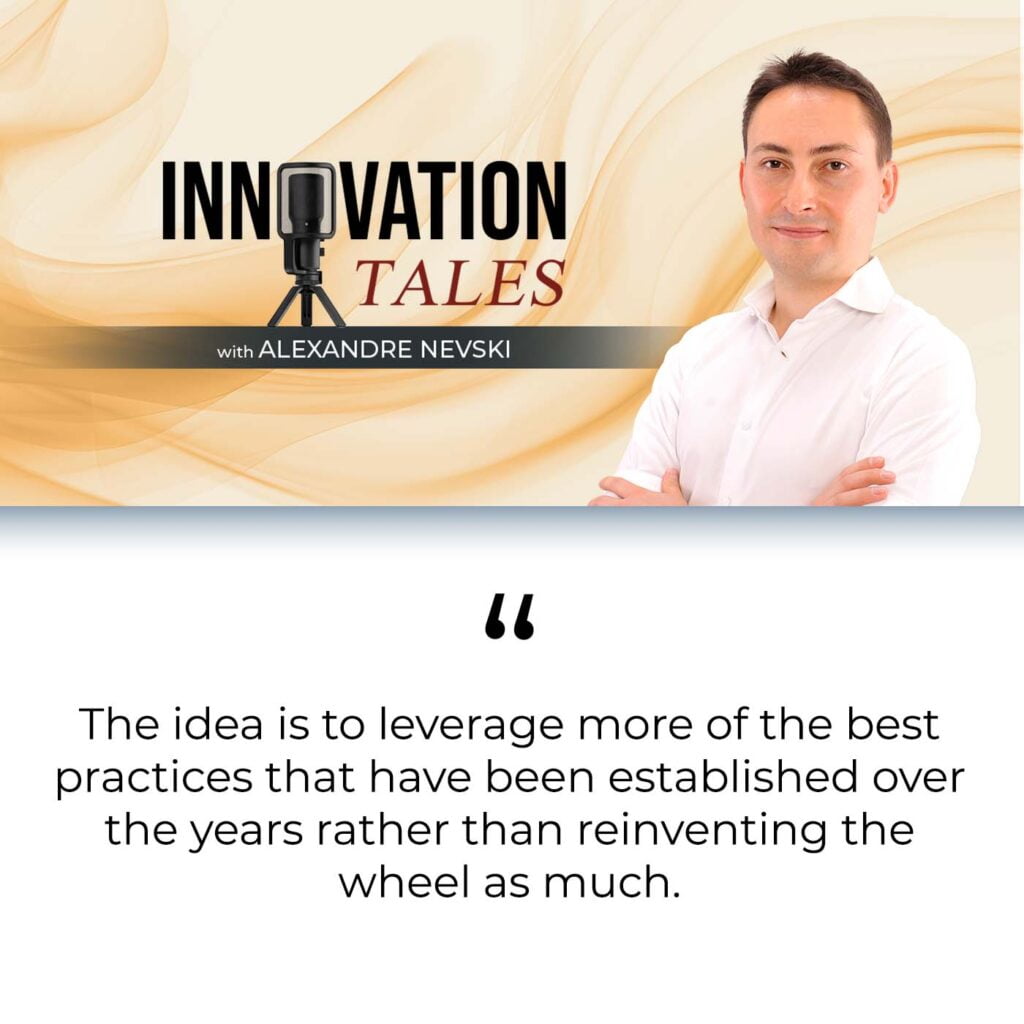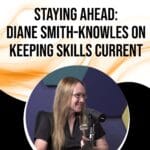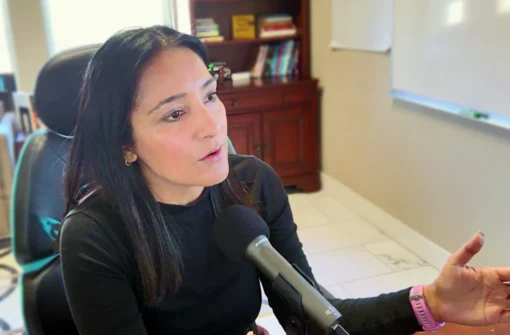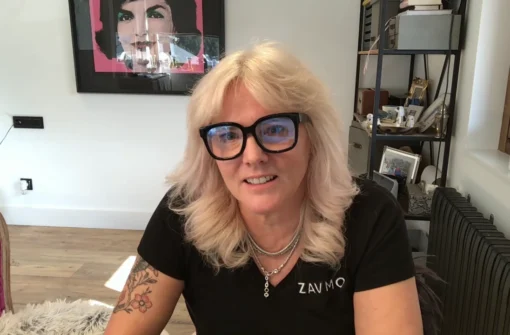
Staying Ahead: Diane Smith-Knowles On Keeping Skills Current
The digital world is evolving fast and is not expected to slow down even one bit. Therefore, those involved in technological innovations and software development must keep their technical skills current at all times. Diane Smith-Knowles, a Partner Success Technical Lead at Pegasystems, explains how leaders can keep their teams up-to-date with the latest trends and updates. She talks about addressing the anxiety and uncertainty around trying new digital methods, especially when such changes are happening at an extremely rapid pace. Diane also discusses the importance of leaders creating a strong rapport with their teams to help them update their skills and further nurture close-knit technical collaborations.
Pega® is a trademark of Pegasystems Inc. Please visit https://www.pega.com to learn more.
Transcript
Every day, we hear about the increasing pace of technological change, but what does it take to keep one’s skills current? What can leaders do to help the people in their organizations stay up to date? I discussed these questions and more with our guest, Diane Smith-Knowles, a Partner Success Technical Lead at Pegasystems with decades of experience in the digital process automation space. Tune in to hear Diane share her passion for developing close-knit technical teams. Diane and her colleagues are widely recognized for their contribution to partner enablement, especially the high-quality deep dive webinars for Pega experts. Without further ado, here’s my conversation with Diane Smith-Knowles.
—
Diane, welcome.

Thank you for having me.
I’m delighted to have you on the show. Innovation Tales focuses on the human side of digital transformation, and I think your team and you do too.
This is true. We’re all about making sure that the people behind the technology are learning and coming up to speed, knowing that even though Pega is built for change, people, not so much.
Let’s try and give our audience a bit of context. What is your team’s remit and what are the methods you use?
Our mission is to ensure that the CLSA community, myself, Braam Smith, and Dion Lammers, are a global team, and that our LSA audience is kept apprised of what’s the latest in the product. Not only that, but also understanding that not all LSAs are on projects that are necessarily on the latest version of Pega. There’s a lot of making sure that we cover topics that are not only the latest from Pega, but we’re understanding where people are at on their projects right now. We know as consultants that delivering applications for our clients is a full-time job, and not everybody has the opportunity to step out and learn new things. “There’s a great new academy mission. Let me go take that.” We don’t often have that luxury of time.
What the need that we’re trying to fulfill is giving a forum for the LSAs to come together. We try to do monthly. That doesn’t always happen, but frequently, multiple times a year, the opportunity to come together and learn what the latest and greatest that Pega has to offer. Answering questions is a big part of what we do and what we find is an important key. In fact, our questions from our audience, because that’s what’s going to tell us where people have gaps and what people want to learn about, we’re really passionate about that. At Pega world, we are so excited to have you approach our booth.
I follow these webinars every time, and some of the questions come from me. I highly advise people who are interested in where the technology is at the moment to follow those webinars. When I was at Pega, the team didn’t exist. There were instructor-led courses and fast-track bootcamp. Eventually, we started running the CLSA immersion programs, which both you and I ran and managed at different times. Do you have an origin story to share with your team?
I’ll start from the Pega Consulting point in time. I was in the field delivering Pega projects like you. I got the opportunity to help out with the lead system architect curriculum at the time, Terry Murphy. Great story, I just ran into him. It’s nice to connect. I started teaching that class. I started teaching the lead system architect class. What was gratifying as I looked back was seeing where people had taken their careers. Some have gone on to deepen their experience within Pega as principal system architects. Some have gone on to start their own companies, just everything in between. That’s been hugely gratifying to me.
That’s where I started as far as the LSA community. I did a little bit of a detour into enablement. I was developing a curriculum for a while, but then found my way back to the LSA community by way of the partner organization. We started during COVID when we lost contact with everybody, and when everybody lost contact with everybody. We started up the system architect webinar series as a way to connect with our audience and bring them. While the rest of the world shut down, we were still building software, and our teams needed to know about that. That’s from 2012 to now, and that’s where we are.
Out of difficulty, it was born. It’s a format that I find is extremely useful. I think you’ve already alluded to some of the challenges that you and your team face, and we in the LSA community face, so definitely not having a lot of time. That’s definitely something that I’m sure a lot of people will recognize. What else is making your job interesting? Why is it not as straightforward as publishing a bunch of pages on the technology?
Part of that, as I mentioned, is the opportunity to interact and ask questions. In this post-COVID era, we’re now finally coming back around to having in-person events. Dion, on my team, was part of the customer site. I did a Constellation event. The opportunity to interact and not just with the LSA webinar, it’s great that we have our Q&A panel, and we really prize those questions. We covet those questions and make sure that our audience gets answers to those questions. It’s not just a one-way pushing out of information from Pega to our community. We want to hear back the questions that people have and talk to people face-to-face. Now that we have this opportunity to start coming together post-COVID, we’re looking to do more of those types of events.
You already mentioned that Pega is built for change, but the people, not necessarily. What did you mean by that?
I don’t know about you, but I like comfort. I like knowing that I have a certain set of expertise and regardless of where I go, “I know how to set up a case type. I know how to do a data model.” I’ve worked with Pega for a long time. I won’t say how many years, but for a long time, there’s comfort in knowing that when you go and talk to somebody, you’re confident that you’re going to have the answer with the changes to the technology, not just Pega, but any technology. The world moves on, and then we have to change with it. Sometimes, that change can be painful and hard, especially when you don’t have time, “When am I going to learn how to do this new thing?” Whatever it is, whether it’s something in the Pega product or anything else that we have to change or learn how to pick up a new skill, that’s hard.
I’ve heard that people don’t change until the pain of staying the same becomes greater than the pain of changing because otherwise, you’re just going to stay in that comfort zone until you’re actually pushed. There are people who love new stuff and jump right into it. My observation, anyway, is that I don’t think that’s the majority. I think people love their expertise and want to hang onto that as long as they can.
Echoes Of Innovation
In the second segment, we use storytelling to bring our audience authentic insights. I always advise my guests to use discretion with names and specifics to honor confidentiality agreements and respect the privacy of the individuals involved. Bearing that in mind, let’s dive deeper. Maybe you have a story you can share that would illustrate that tension that you’ve mentioned. Staying in comfort versus being up to speed. That’s a story that would help our audience understand where the difficulties come from.
We’ve been preparing a series called Squashing Constellation Myths. We’ve delivered that a couple of times. This is a recent example. I’ve been learning along with the rest of our ecosystem, all that Constellation has to offer. It all sounds great in theory, and you look at all the architecture diagrams and you’re like, “This is the right technical decision to make for Pega,” but I still wasn’t, in my own mind, convinced. I like my action sets. I like being able to style up the UI in the way that I want to. I could sense and understand how if you’re on a project and the client is asking you to change a button, you’ve been able to back to the, “I’m comfortable with my expertise. I can do that in a split second. No problem.”
There’s been quite a stir, I think is the word, in the last few years now. At least, that’s the timeframe maybe not from the technology perspective, but from what people are saying. I’ve seen, or I felt more, not resentment, but a lot of anxiety in the last few years from the practitioners who are concerned that they might not be able to deliver the same type of service that they have been able to deliver because the technology is changing. From where you stand, you engage with almost all the CLSAs and all of the experts. Is that also something that you’ve been observing?
Absolutely. There’s a lot of consternation of, “I need to get this delivered to my client in two weeks.” I am struggling mightily with this particular technology and being patient as I’m working in my partner delivery role, working with our partners and explaining, first of all, because they’re coming at us a little bit about this, “Why is this hard?” Once you catch how Constellation renders the UI, and the fact that the data model is going to drive and render, Pega is doing the work for you, you just have to let go. I had to reach that point myself as I was preparing to do one of these myth-busting or myth squashing. You hear the five myths about Constellation, and we’re going to go through and systematically squash each of those.
As I was preparing for that myself, I was going through one of the demo exercises that my colleague, Braam, had brought to bear. It clicked for me. I see why the data model is key here in making sure that the data types are well thought out and of the right type because Constellation is providing that UI for you. I don’t have to go and configure a search and select or a modal or anything that my old way, the way that I like and was stuck with, would’ve told me to do my instincts. I had to go against my instincts a little bit. Once I had that ‘see the light’ moment, it all clicked. I see the benefits of this.
What’s the first moment when they actually are challenged? What usually brings that about?
Usually, I have to deliver this user story by the end of the sprint, or the client is asking me to provide a button. In Constellation, I don’t see how to do that. I don’t see if there’s even a way to do that in the steps. Recognizing A) What the client is asking you to do, agreeing upon that, and then seeing if there’s a way that the product will support what you’re asking to do without having to go and hand code some HTML, a JavaScript, or whatever it is.
It starts with a practical challenge. It’s interesting that it doesn’t start with the webinars when a new feature comes out, it starts looking at what’s possible and what’s not at that point. Most people, like you said, don’t have time to play around with a new piece of tech until they have to deliver. Is that a fair statement?
That is a fair statement. It’s not until you’re presented in your day-to-day with some task or a challenge that all of a sudden, the way that you’ve provisioned maybe half a day to get this thing done, then you go and you try to set it up or configure it. This is a, “I can’t get this to work.” That’s when the anxiety sets in. I can feel the anxiety. When our partners or community comes to us and says, “I’m trying to do this and I can’t get this to work,” then going through that process of A) Understanding what it is they’re trying to accomplish, then B) Finding out does the product support what you’re trying to do, but maybe in a different way.
Discomfort mainly happens in the digital ecosystem when developers try to do things differently.
I think that’s where the discomfort comes in as well. Our delivery teams aren’t used to going back and saying, “Let’s look at this in a different way, and here’s why we should be looking at this in a different way because it’s going to help with future upgradeability. It’s going to help with the speed of your application, but we have to think about this in a slightly different way.” That’s where the challenge comes in.
That’s where we need to go as an ecosystem to not just educate on the technical, the mechanics of the product, but delivering that message of, “Let’s think about this problem in a little different way.” We’re focusing on Constellation here, but there are ways to configure it to meet a very specific client need. Let’s see what the product can do for us before we start going down this path. It’s funny, with UI, it’s what everybody sees, and everybody gravitates to the UI.

I agree. Although, to me, it’s now in the product. It’s now something that pretty much you have to do. To me, this was the best practice all along with this specific topic. I know it’s just an example, but there was always this tension. Do we build a custom UI because somebody is asking us for it, or do we find that we become creative and we broaden our understanding of the problem?
Instead of fixating on the solution, we spend time in the problem space. In my view, that should have been happening all along. Now, it’s part of the product, now it’s unavoidable. What would you say indicates that in one case, the person is going to feel comfortable with learning how to do it in a different way versus the situations where there’s going to be more frustration?
It’s hard to know. Everybody is different. Everybody has a different capacity for learning. Before they say, “Help, I need to send an email to my team,” or in a ticket even, it might come back around to us, in addition to the, “Have you checked out these resources? Have you watched this?” Walking through with a simple example with somebody, and I know this isn’t necessarily scalable, but I think I find that this to be most effective, “Let’s take ten minutes to walk through an example of what you’re trying to achieve.” As you mentioned, take another crack, “Let’s look at the problem itself. Maybe there’s another way to solve it.” You can’t remove somebody’s anxiety from them. If only, but you can walk with them through that time in a different way.
One of the predictors, what I’m hearing, is that it’s the access they have to somebody who can bring them along.
That’s something that we’re trying to work on with the community at large. Our mission, we don’t want to just be constantly saying, “It’s Braam, Dion, and Diane again. They’re going to talk to us about what we’ve already heard about.” We want the community to engage. What’s been helpful is the LinkedIn space to get some of that conversation going. If the community has ideas on things to cover, we want to know so that we can facilitate those conversations. We’d love to get to the point where it’s not just us doing these webinars. It’s the community coming in, “Can I be a guest? I have a good story to tell about the success with cloud migration.”
It sounds like Constellation wasn’t just a unique example that that kind of adoption challenge is something that is recurrent.
Remember, people are not built for change so much. We adapt, but not without a lot of grousing and complaining along the way. I’ll speak for myself. I can’t speak for everybody, but it’s what I’ve seen.
Blueprints Of Innovation
Before we move on to the next segment, if you found this show inspiring, please like and subscribe to help us reach a wider audience. In this second segment, it’s a little bit shorter. We focus on tools and methods that we might have mentioned previously. Let’s go through the acronym that we’ve mentioned first. For us, it’s obvious. What is a CLSA?
Certified Lead System Architect.
What does that represent in the Pega space?
That is the highest technical certification that we offer. It represents years, although not necessarily, but often years of experience with Pega, developing with Pega. It proves by way of certification that the person who holds that certification has a deep understanding of not only how to implement Pega, but how to architect solutions for Pega.
Let’s expand this to what is the CLSA community?
The CLSA community is at least 2,000 people in the ever-growing number of Pega professionals, who most of them have invested their careers in Pega. That community shares ideas with one another and brings to bear years of well-thought-out opinions, some of which are very strongly held and sometimes need to be adjusted maybe. They’re the top-tier Pega architects and implementation leads out in the ecosystem.
Your team, as you described, serves this community. What are the methods? You’ve mentioned the webinars. Can you maybe elaborate on that a little bit more?
We started the webinar series during COVID as a means to reach out to this audience. One other thing I should add to the CLSA definition is that this group of folks has quite a bit of influence over our clients and our delivery teams. They’re very well-respected, and we want to make sure that they have all of the information and tools, and have a channel. That’s why we started this webinar series, so they have a channel to ask questions and get clarification.
The last term I think that we ought to define is simply Constellation, as we’ve mentioned in this story. What is Constellation?
Constellation is Pega’s UI architecture. It is react-based and no longer section-based. This is what we’re moving forward with as a company. It’s an altogether different UI architecture than we’ve had in previous versions. All based on react, and if I say any more than that, I’ll probably start getting into way too much detail. It’s a modern UI architecture.
It’s very modern. I’d say that it’s more prescriptive. The idea is to leverage more of the best practices that have been established maybe over the years rather than reinventing the wheel as much.

With a prescribed design system when you look at Constellation with Pega. It’s very well-branded.
Innovator’s Playbook
In this third and final segment, we aim to bring our audience practical advice. You’ve described the challenges that an individual might go through to stay current. Maybe what we’ve talked about is that it’s a time investment, that it’s also getting out of their comfort zone. Let’s unpack this but from the point of view of a digital transformation leader. They’re going to have an organization, a team, or several teams helping them deliver. Let’s say their teams are struggling to stay up to date. What would you recommend to them?
Taking the time investment to step back and understand, making sure that the delivery teams understand what the vision is for Pega at the organization, using Pega and digital transformations anonymously here. Taking that time to reorient around what it is we’re doing because I think it’s very easy to fall into the day-to-day, build this, deliver that and complete this user story when the teams don’t have a reason to change or have a reason to invest in keeping their skills current. If they don’t see that, “We’re not keeping up with the latest and greatest Pega, why should I take the time out of my day to learn something new?” Taking a step back as a team, and this requires backing from the leadership and stakeholders, that this is going to be a valuable use of time to reorient around what we are doing and why we are doing this.
Once a technical team understands their vision and what they are doing to achieve that, everyone can come together in coming up to speed on staying current with their skills.
The keynote at Pega world from T-Mobile was great. We’re talking about customer, “We’re losing all these customers. What’s going on?” Let’s reorient on loving our customers, so what does that mean? That could take a long time, but I think when teams see what the vision is and what the organization is trying to drive to, and it’s usually a very simple statement. Customers love T-Mobile. That’s what stuck out to me. Then sifting through or making decisions based upon day-to-day decisions based upon what that mission is, and then that’s going to drive a whole other set of behaviors.
Once you understand what that vision is and what you’re driving to, then, “I see why I need to come up to speed on staying current. What’s the latest? What’s the tooling, the technology, and the feature set that’s going to allow us as an organization to achieve that mission?” There are a lot of steps between here and there. What’s the motivation? It’s a question of motivation, I think.
What I’m hearing is that the first and foremost step is making sure that people have a reason. The question is why, and for them to have an answer that makes them want and commit resources, time to come up to speed, they need to see this as a longer-term investment. That this is not something that will finish, let’s say, a project that finishes in two months and that’s it. Let’s maybe spend some time on the human side of coaching and mentoring. This is how I see it. You have so much experience with mentoring the community and also working with teams. What kind of insights can you share with our audience that determine how they experience their journey?
First and foremost, what I’ve found to be most effective is that the person that you’re mentoring needs to know that you care about them, and you care about them as people. Not just their career progression or their technical skills, but I care about you as a person, first and foremost, and then I see where you can go. I see your potential. How can I help you achieve that?
Make sure that you share that driver, that vision of where you see yourself going, and pour in and making that commitment to the person. Not just, “Are they going to tick these boxes? Did they get these certifications?” It’s awesome if they do, and I’ll offer a hardy congratulations when you do. I care more about your fulfillment and seeing you achieve what you want to achieve and helping you to get there.
Establishing rapport and having not a transactional view of the mentoring but a relational view. It’s not always the case. What are the challenges?
Sometimes, people don’t care enough themselves. You’re trying to help them what you thought they wanted to achieve, but it turns out that they’re too comfortable perhaps, and don’t see the need to change or want to learn. That can be heartbreaking, especially after you’ve poured into someone for a period of sometimes years, and having them walk away or sever a relationship is always hard.
As we get close to the interview, are there any final thoughts you’d like to leave our audience with?
Don’t be afraid to change. Don’t be afraid to learn new things. Just start, get your hands dirty. One of the biggest blockades, I think, is particularly with these LSA webinars, it’s a lot of taking in, and then we go about our business, we go about our day, but actually putting in the effort to now turn around and build something on your own build-up project. For example, you’ll like this one. I’m going to do a blueprint on podcasts, so coming to a theater near you. That’s a very real example of something that we go through in our day-to-day lives, and this would make a great Pega application.
Do not be afraid to get your hands dirty and try something new.
The takeaway is don’t be afraid to get your hands dirty. Try something new. With Blueprint, it’s easy to get your hands in there, build something out, and then take it into the app and evolve it and build it out. The other thing I’m learning right now is going through a YouTube playlist of AWS, like web services. I spun up my AWS trial and played around with that. Get your hands dirty. Open up the hood and start tinkering. You might break something, but that’s okay.
It’s a great way to end. Thank you very much for coming to the show, Diane.
You’re welcome.
—
That’s a wrap for this episode. I hope my conversation with Diane inspired you to try the strategies she shared to stay current and help your teams do the same. I highly recommend that your experts participate regularly if they aren’t doing so already. As always, we have more topics and guests signed up. Stay tuned for more tales of innovation that inspire, challenge, and transform. Until next time, peace.
Important Links:
- Pegasystems
- Diane Smith-Knowles – LinkedIn
- https://Community.Pega.com/Events?f%5B0%5D=Events_Project_Role%3ARole9§ion=Replay
About Diane Smith-Knowles

Diane Smith-Knowles is a Partner Success Technical Lead at Pegasystems, with nearly two decades of experience in the digital process automation space. She is passionate about developing close-knit technical teams and mentoring team members to become leaders themselves. Widely recognized for her role in enabling partners and her deep expertise, Diane is an invaluable contributor to Pegasystems’ success.






